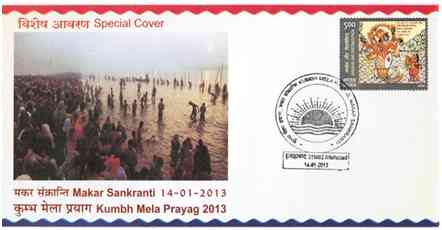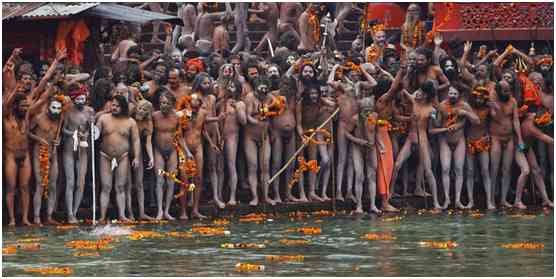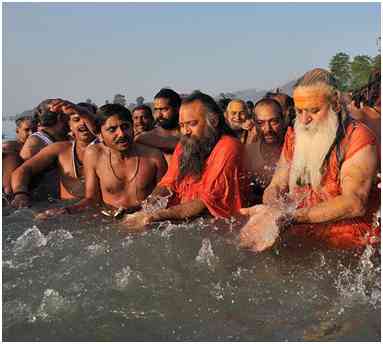 |
INTERESTING FACTS ABOUT THE KUMBH MELA
Compiled by Disha Kathuria 
“It is wonderful, the power of a faith like that, that can make multitudes upon multitudes of the old and weak and the young and frail enter without hesitation or complaint upon such incredible journeys and endure the resultant miseries without repining. It is done in love, or it is done in fear; I do not know which it is. No matter what the impulse is, the act born of it is beyond imagination, marvellous to our kind of people, the cold whites.”
-- Mark Twain in 1895, after visiting the Kumbh Mela

- Kumbh Mela is organized every three years on a rotation basis in Allahabad, Nashik, Haridwar and Ujjain. It is a mass Hindupilgrimage in which Hindus gather at the Sangam, meeting place, of the rivers Ganges, Yamuna and Sarasvati, and on the banks of Godavari, Ganga and Kshipra where bathing for purification from sin is considered especially auspicious.
- It’s the world’s biggest fair
- The festival is billed as the "biggest gathering on Earth"; in 2001 more than 40 million gathered on the busiest of its 55 days. The 2001 mela was unusually significant due to the planetary positions at the time, a pattern that repeats only once every 144 years.
- Mela takes place when the planet Jupiter enters Aquarius and Sun enters Aries.
- Kumbha Mela is held at all the four places
- Ardha Kumbha Mela: Held at Haridwar and Prayag (Allahabad), every 6 years
- Purna Kumbha Mela: Only at Prayag, every 12 years
- Maha Kumbha Mela: Only at Prayag, every 144 years
- First written evidence of the Kumbha Mela can be found in the accounts of Chinese traveller, Hiuen Tsang or Xuanzang (602 - 664 A.D.) who visited India in 629 -645 CE, during the reign of King Harshavardhana.
- According to The Imperial Gazetteer of India, an outbreak of cholera occurred at the 1892 Mela at Haridwar, which led to the rapid improvement of arrangement by the authorities and the formation of Haridwar Improvement Society, and in 1903 about 400,000 people attended the fair. During the 1954 Kumbh Mela stampede at Allahabad, around 500 people were killed, and scores were injured. Ten million people gathered at Haridwar for the Kumbh on April 14, 1998. Around 10 million people from around the world participated in the 'Maha Kumbh Mela' at Prayag (Allahabad) in 2001.
- Various sadhus (hermits) visit the Mela; including Nagas, who do not wear any clothes; Urdhwavahurs, who believe in putting the body through severe austerities; Parivrajakas, who have taken a vow of silence; Shirshasins, who stand 24 hours and meditate for hours standing on their heads; Kalpvasis, who bathe thrice a day.

- It’s a spectacle to behold various akharas making it to the river for the great bath on Kumbh days. An akhara is a wrestling arena. It is an organization of the different sects of saints, vairagis, and yogis who have renounced the world. Akharas are divided into different camps according to the concept of God they worship. Shaiva Akharas are for followers of Lord Shiva, Vaishnava or Vairagi Akhara are for followers of Lord Vishnu and Kalpwasis are for followers of Lord Brahma. An Akhara is further divided into 8 davas (divisions) and 52 marhis (centers). Each marhi performs its spiritual activities under a Mahant. The central administrative body of the Akhara is Shree Panch (the body of five), representing Brahma, Vishnu, Shiva. Shakti and Ganesha. The five-member body governing an akhara is elected during every Kumbh Mela for a period of 4 years.
- The major event of the festival is ritual bathing at the banks of the river in whichever town it is being held that is:
Ganga in Haridwar, Godavari in Nashik, Kshipra in Ujjain and Sangam (confluence of Ganga, Yamuna and mythical Saraswati) in Prayag (Allahabad).
- The next Kumbh will be held at Ujjain (MP) on the banks of river Shipra in 2016. The Kumbh at Ujjain is also called "Simhastha."
- It is believed that one day and night in heaven makes one human year. The fight between Gods and Demons went on for twelve days and twelve nights equal to twelve human years. That is why Kumbh mela is celebrated every twelve years.
- In 2010 Indian Space Research Organisation took satellite pictures of the crowds with the hope of improving the conduct of the festival in the future
- Amrita Kumbher Sandhane, a 1982 Bengali feature film directed by Dilip Roy, documents the Kumbh Mela.
IMPORTANT DATES MAHAKUMBH 2013
- Paush Purnima – 27th January
- Ekadashi snan – 6th February
- Mauni Amavasya snan – 10th February
- Basant Panchmi snan – 15th February
- Rath saptami snan – 17th February
- Bhisma Ekadashi snan – 18th February
- Maghi purnima snan – 25th February
MOST SIGNIFICANT EVENTS DURING THE MELA
Makar Sankranti: A Holy bath during this period carries special significance. Those who take a holy bath in the rivers Ganga, Yamuna, Godavari, Krishna and Kaveri acquire pious credits.
Paush Purnima: The day occurs when the moon is full in the Hindu month of Paush. This is the last full moon of winter. By this time, the sadhu and hundreds of thousands of pilgrims arrive at the Kumbh Mela.
Mauni Amavasya Snan: For the holy men and women, this is the main bathing day. New members to various holy monastic orders receive their first initiation on this day.
Basant Panchami Snan: This is the fifth day of the luminous half of the lunar month and is the beginning of spring in North India.
Rath Saptami Snan: Rath Saptami festival is observed on the seventh day of Shukla Paksha in the Magh Month (January – February) in the traditional Hindu calendar.
Bhishma Ekadashi Snan: On this day, Bhishma Pithamaha, the oldest, wisest, most powerful and most righteous person belonging to the Kuru dynasty (approx. over 5000 years ago), narrated the greatness of Lord Krishna through Sri Vishnu Sahasranama to Yudhishtira, the oldest brother of Pandavas.
SIGNIFICANCE OF THE HOLY WATERS DURING KUMBH MELA
Kumbh's history originates from the beginning of the Creation of universe. The Gods had lost their strength, and to regain it, they thought of churning the Ksheera Sagara (Primordial Ocean of milk) for amrit (the nectar of immortality), this required them to make a temporary agreement with their arch enemies, the demons or Asuras to work together, with a promise of sharing the nectar equally thereafter. However, when the Kumbha (urn) containing the amrita appeared, a fight ensued. For twelve days and twelve nights (equivalent to twelve human years) the gods and demons fought in the sky for the pot of amrita. It is believed that during the battle, the celestial bird, Garuda the vehicle of Vishnu flew away with the Kumbha of elixir, and that is when drops of amrita fell at four places on earth: Prayag, Haridwar, Ujjain and Nashik, and that is where the Kumbh Mela is observed every twelve years.
WHAT HAPPENS TO THESE HOLY WATERS DURING KUMBH MELA?
- Once in every 12 years, the same astrological configuration falls into place. It is a planetary conjugation in space – a conjugation similar to the placement of planets during the period of The Great Churning (Samudra Manthan).
- This conjugation triggers the bubbling of all Holy Waters into which drops of Nectar (Amrit) fell.
- At Allahabad, the invisible Saraswati that flows beneath the surface of Mother Earth, starts spurting Cosmic Energy. This Energy flows & merges into the point of Confluence where it meets Ganga & Yamuna at the point of Triveni Sangam.
- At Haridwar, this Cosmic Energy starts spurting in the Ganga, deep within the waters, at the point of Har-ki-Pauri. At Ujjain, this Energy flow happens in the centre-point of River Kshipra that flows adjoining to the Mighty Mahakaaleshwar temple.
- And at Nashik, this Cosmic Energy starts bubbling deep down in the River Godavari, at the point that flows adjoining to the Holy Tryambakeshwar temple.
- Water being the fastest and quickest element to be energized, this Cosmic Energy spreads in these Holy Waters to a radius of 45kms. Within this orbit of these 45kms of the invisible bubbling source of the highest Cosmic Energy – lies the secret to human redemption, salvation and immortality. That’s the secret of Kumbh Mela.
- Nectar keeps on spurting into these Holy Waters for the entire period/duration of the Kumbh Mela. When we take a dip in these Holy Waters, during that time, the subtle energy points in our human aura and our physical human body absorb these Cosmic Energies fully. These Energies effect a change in the mind, body & spirit – and thereby they automatically affect our destinies for the better.
- These Energies also create a direct Cosmic Link to Heavens, where you will receive subtle help to absolve you of past misdeeds (sins); cleanse your mind for new, fresh beginnings; and allow you a clean slate to pen a better tomorrow.
- The auric absorption of these Energies is so high that, that the subtle link it creates into Heavens above extends straight up to our Ancestors in the Ethers. It’s like a Cosmic Ladder.
- And when the Energies of our aura, tinged with the Energies of this Nectar from the Holy Waters of Kumbh Mela, touch our Ancestors – their destinies too are changed, for the better, in the Akashic Records (Cosmic Past Files).
- This Cosmic Ladder Link can touch up to the 88th generation of Ancestors in the past – and purge and absolve them too (your ancestors) of their “earthly” sins during their time on Earth. 88 generations into the past is like going back in time; almost to the point of creation. Can you even begin to imagine the blessings that will rain upon you from your Ancestors, from Heavens above?
- The Poorna-Kumbh cycle of 12 years corresponds to the approximate 11.1 years of the Sun-Spot cycle. The Sun-Spot cycle is known to enhance the electro-magnetic field of the earth – which in turn effects the environment and the bio system. The electro-magnetic field of the body is similarly enhanced, thereby affecting the nervous, endocrine, circulatory and respiratory system – in a manner that is similar to meditation.
KUMBH MELA IN MEDIA
- Kumbha Mela has been theme for many a documentaries, including "Kumbh Mela: The Greatest Show on Earth" (2001) directed by Graham Day.
- On April 18, 2010, a popular American morning show The CBS Sunday Morning gave an extensive coverage on Haridwar's Kumbh Mela "The Largest Pilgrimage on Earth". Calling it "one of the most extraordinary displays of faith on Earth, a spectacular journey drawing tens of millions of people".
- Short Cut to Nirvana: Kumbh Mela is a 2004 documentary film was set in the 2001 Maha Kumbh Mela at Allahabad. This film is directed by Nick Day and produced by "Maurizio Benazzo".
- On April 28, 2010, BBC reported an audio and a video report on Kumbh Mela, titled "Kumbh Mela 'greatest show on earth'".
- On September 30, 2010, the Kumbh Mela featured in the second episode of the Sky One TV series "An Idiot Abroad" with Karl Pilkington visiting the festival.
- "Amrit Nectar of Immortality" (2012) is a documentary which was shot at the Kumbh Mela 2010 in Haridwar, this film is directed by Jonas Scheu and Philipp Eyer.
|
 |